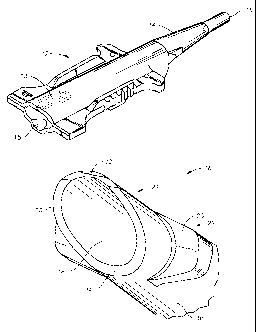Some of the information on this Web page has been provided by external sources. The Government of Canada is not responsible for the accuracy, reliability or currency of the information supplied by external sources. Users wishing to rely upon this information should consult directly with the source of the information. Content provided by external sources is not subject to official languages, privacy and accessibility requirements.
Any discrepancies in the text and image of the Claims and Abstract are due to differing posting times. Text of the Claims and Abstract are posted:
| (12) Patent: | (11) CA 2624036 |
|---|---|
| (54) English Title: | LENS INJECTOR LUMEN TIP FOR WOUND ASSISTED DELIVERY |
| (54) French Title: | LUMIERE D'INJECTEUR DE LENTILLE POUR MISE EN PLACE PAR UNE INCISION |
| Status: | Granted and Issued |
| (51) International Patent Classification (IPC): |
|
|---|---|
| (72) Inventors : |
|
| (73) Owners : |
|
| (71) Applicants : |
|
| (74) Agent: | KIRBY EADES GALE BAKER |
| (74) Associate agent: | |
| (45) Issued: | 2010-05-18 |
| (22) Filed Date: | 2008-03-04 |
| (41) Open to Public Inspection: | 2008-12-12 |
| Examination requested: | 2008-03-04 |
| Availability of licence: | N/A |
| Dedicated to the Public: | N/A |
| (25) Language of filing: | English |
| Patent Cooperation Treaty (PCT): | No |
|---|
| (30) Application Priority Data: | ||||||
|---|---|---|---|---|---|---|
|
A cartridge for an IOL delivery system that is specifically designed to aid in wound assisted IOL delivery. The distal tip of the nozzle has an extended canopy which serves to open the incision and support the IOL. Peripheral protrusions, flanges, or stops extending laterally from the side of the distal tip provide a positive depth limitation, and prevent the full insertion of the nozzle into the incision. In addition, the protrusion provides support to the incision to reduce the tendency of wound damage through tearing.
Une cartouche pour un injecteur de lentille intraoculaire (IOL) spécifiquement conçue pour faciliter la mise en place de l'IOL par incision. La pointe distale de l'embout comporte un protecteur allongé qui sert à élargir l'incision et à supporter l'IOL. Des renflements, des brides ou des butées périphériques qui se prolongent latéralement à partir du côté de la pointe distale limitent positivement la profondeur et empêchent l'insertion complète de l'embout dans l'incision. De plus, le renflement supporte l'incision de manière à réduire la tendance de celle-ci à se déchirer.
Note: Claims are shown in the official language in which they were submitted.
Note: Descriptions are shown in the official language in which they were submitted.

2024-08-01:As part of the Next Generation Patents (NGP) transition, the Canadian Patents Database (CPD) now contains a more detailed Event History, which replicates the Event Log of our new back-office solution.
Please note that "Inactive:" events refers to events no longer in use in our new back-office solution.
For a clearer understanding of the status of the application/patent presented on this page, the site Disclaimer , as well as the definitions for Patent , Event History , Maintenance Fee and Payment History should be consulted.
| Description | Date |
|---|---|
| Inactive: Recording certificate (Transfer) | 2020-01-24 |
| Inactive: Recording certificate (Transfer) | 2020-01-24 |
| Inactive: Recording certificate (Transfer) | 2020-01-24 |
| Common Representative Appointed | 2020-01-24 |
| Common Representative Appointed | 2020-01-24 |
| Common Representative Appointed | 2020-01-24 |
| Inactive: Single transfer | 2019-12-18 |
| Common Representative Appointed | 2019-10-30 |
| Common Representative Appointed | 2019-10-30 |
| Change of Address or Method of Correspondence Request Received | 2018-01-09 |
| Grant by Issuance | 2010-05-18 |
| Inactive: Cover page published | 2010-05-17 |
| Pre-grant | 2010-02-08 |
| Inactive: Final fee received | 2010-02-08 |
| Notice of Allowance is Issued | 2010-01-04 |
| Notice of Allowance is Issued | 2010-01-04 |
| Letter Sent | 2010-01-04 |
| Inactive: Approved for allowance (AFA) | 2009-12-23 |
| Amendment Received - Voluntary Amendment | 2009-11-19 |
| Inactive: S.30(2) Rules - Examiner requisition | 2009-10-05 |
| Application Published (Open to Public Inspection) | 2008-12-12 |
| Inactive: Cover page published | 2008-12-11 |
| Inactive: IPC assigned | 2008-07-23 |
| Inactive: First IPC assigned | 2008-07-23 |
| Inactive: IPC assigned | 2008-07-23 |
| Amendment Received - Voluntary Amendment | 2008-07-17 |
| Filing Requirements Determined Compliant | 2008-04-16 |
| Inactive: Filing certificate - RFE (English) | 2008-04-16 |
| Letter Sent | 2008-04-15 |
| Application Received - Regular National | 2008-04-15 |
| All Requirements for Examination Determined Compliant | 2008-03-04 |
| Request for Examination Requirements Determined Compliant | 2008-03-04 |
There is no abandonment history.
The last payment was received on 2010-02-23
Note : If the full payment has not been received on or before the date indicated, a further fee may be required which may be one of the following
Please refer to the CIPO Patent Fees web page to see all current fee amounts.
Note: Records showing the ownership history in alphabetical order.
| Current Owners on Record |
|---|
| ALCON INC. |
| Past Owners on Record |
|---|
| DAVID A. DOWNER |
| KHIUN F. TJIA |